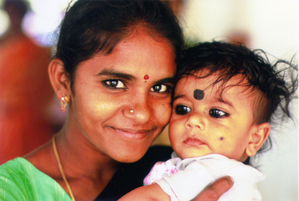Integrating human milk banking into newborn care
|

Worldwide each year 3.3 million infants die in the first month of life. India takes the lead with 779,000 deaths (29 deaths/1000 live births). Neonatal mortality constitutes 56% of the total under-five mortality (52 deaths/1000 live births) in India .
As New Delhi hosts the Call to Action Summit 2015 - to gather momentum around ending preventable child and maternal deaths, it is important to underscore that breastfeeding is one of the most powerful interventions for reducing infant mortality, including neonatal mortality. India can reduce preventable newborn deaths by integrating breastfeeding promotion into antenatal and postnatal care, increasing accessibility to human milk banks (HMB), and adopting Kangaroo Mother Care into the newborn care program.
Eminent professor of neonatology at the All India Institute of Medical Sciences in New Delhi, Dr. Ashok Deorari, has often emphasised that evidence has shown that the nutrition and immunity in donor human milk is superior to formula; it reduces the risk of deadly infections—particularly sepsis and a condition called necrotizing enterocolitis. Human milk improves survival rates and reduces the duration of hospital stays, making HMB a lifesaving and cost-effective intervention. Although HMB is not a new concept to India, it has not yet scaled to its full potential, with only 20 milk banks established from 1989 and 2015.
Earlier this year, PATH and the Norway India Partnership Initiative (NIPI) facilitated a learning exchange programme in Rio de Janiero, Brazil. This opened new avenues for India to step up its HMB initiative. This learning exchange has helped act as a stimulus and is facilitating discussions among the medical fraternity and Government in India to scale up and strengthen HMB in the country through stronger government involvement, network formation, and investment in implementation research to support the formation of simplified and localized HMB systems.A HMB network formation meeting is now being organized to formalize robust India-specific Standard Operating Proceduresand the sharing of best practices to promote the Mother Baby Friendly Initiative+ (MBFI+) model, which integrates HMB systems and Kangaroo Mother Care into breastfeeding promotion.

Participants of the learning exchange programme in Rio de Janiero, Brazil.
Mr. Arthur Chioro, Minister of Health of Brazil, has also invited the Indian Minister of Health, Mr. J. P. Nadda, to attend the International Cooperation Forum being organised by the Brazilian Government to celebrate 30 years of public policy for the Human Milk Banking cooperation.
While recently chairing a panel discussion at the India Academy of Paediatrics conference, Dr. Ajay Khera, Deputy Commissioner of Child Health and Immunization for the Government of India, stated that the government had already established 575 Sick Newborn Care Units (SNICU) in the country, formulated guidelines for Kangaroo Mother Care, and committed to formulate guidelines on the HMB system and scale it up across the 575 SNICUs as an integrated model.
Interestingly, there are mothers in India who are now aware and want to give their excess milk to any baby in need. It is also a reality that thousands of mothers face challenges due to malnutrition, complications in childbirth, and a lack of knowledge and of optimal lactation support in India. Human milk banks could provide an answer to the high under-five mortality rate in India.
Photo credits, top to bottom: PATH/Arvind Chengi; Kimberly Amundson.














